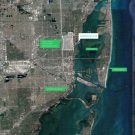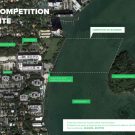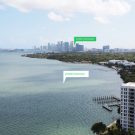Solutions for floating housing in Miami’s Biscayne Bay, USA.
Register: NOV/08/2022, Submit: NOV/09/2022, Eligibility: Anyone, architects, architecture students, designers; individually, (interdisciplinary) teams up to 4 members (it is recommended that at least one member have an architectural background), Fee: 55 USD (MAY/03/2022 – AUG/02/2022), 75 USD (AUG/03 – SEP/27/2022), 95 USD (SEP/28 – NOV/08/2022), Awards: Overall Award: 5,000 USD, 3 Runners-up Awards: 1,000 USD each, 10 Honorable Mentions, Director’s Choice Awards
Miami is facing two major emergencies. First, it has become the least affordable US city to live in. Its housing stock has been depleted by its quickly growing population, accelerated by more people moving during the recent pandemic. Recent reports suggest nearly 1000 people are moving to Florida each day. New developments are pushing rental rates and costs of housing higher, making areas now unaffordable, and pricing people out of their neighborhoods.
Miami’s second major emergency comes from the growing realization that its housing is greatly threatened by rising sea levels caused by climate change. Miami Dade County contains 26% of all U.S. homes at risk from sea level rise. Some insurance companies are canceling service for high risk flood zones, potentially leaving a portion of the population homeless after a major hurricane.
These two problems, combined together, demand new solutions for housing in Miami. How can we design solutions that not only create affordable housing but also make it resilient to the looming problem of sea-level rise?
CHALLENGE
The problems of sea-level rise and housing affordability in Miami merge together as a new phenomenon called “climate gentrification”. Current residents of neighborhoods located on higher ground within the city are being displaced by coastal residents looking to escape the rising seas and flooding.
Little Haiti and Little River are two bordering neighborhoods located north of downtown Miami just west of Biscayne Bay. They have rich cultural histories filled with Haitian and Caribbean residents who have lived in these neighborhoods their entire lives, and some for multiple generations. However, recently they have become hotspots for new developments and climate gentrification. This is primarily due to parts of the neighborhood having higher elevations that attract developers to invest in new buildings, making rent and home prices rise higher than the longtime residents can afford. The northern edge of these areas is at high risk of sea-level rise due to its proximity to the Little River Canal, further amplifying the number of displaced residents.
The recent development and revitalization of the neighborhoods brings about its own underlying uncertainties: will longtime residents be able to find affordable housing near their current homes and communities? And, if so, how can they protect themselves from the risk of being displaced again due to sea level rise?
Arch Out Loud is calling on designers to propose solutions for floating housing in Miami’s Biscayne Bay.
PROGRAM
Designers should interpret the program as they feel best addresses the concerns of the brief. There is no required scale other than the minimum unit count below.
REQUIRED PROGRAM ELEMENTS
Residential Units
Projects should contain a minimum of 45 units that can be designed together or separate.
- The type of units should be an equal mix of 1-bedroom, 2-bedroom, and 3-bedroom units
- The project will be designed as affordable housing
Docks
Projects should include dock spaces that are used to store resident’s means of water transportation.
- minimum 1 dock space per unit
OPTIONAL PROGRAM ELEMENTS
Shared amenities
Projects should consider outdoor and indoor shared spaces that could include, but is not limited to:
- playground
- pool
- gym/fitness centers
- laundry facilities
- gardens
- green space
OBJECTIVES
- Explore the potentials of floating architecture.
- Investigate strategies for affordable housing.
- Consider how this housing can connect to its nearby communities, especially Little Haiti and Little River.
- Study how new developments in Biscayne Bay could enhance or create new ecosystems around them.
- Propose resilient solutions for the residents to adapt to the forthcoming effects of climate change and the variation of flooding types.
FLOATING HOUSING
Unlike other cities around the world, Miami cannot just block off water from entering its streets. Water comes up through the ground. Most of the city sits on top of porous limestone that makes it uniquely vulnerable to flooding and the consequences of climate change. Along with rising seas, the city is affected by other forms of flooding, such as a rising water table, storm surge, and rainwater. This rapid variation of flooding poses a major challenge for our primarily static buildings.
In a spectrum of strategies for adapting to various forms of flooding, floating buildings seem to be one of the most radical. However, it might be the most suitable. Floating homes allow for the most flexibility as they can rise and shift in any direction as necessary. In contrast to our often static buildings, floating architecture is a dynamic approach that makes buildings more easily adaptable to the unpredictable effects of climate change.
Various strategies can be used to make a home float. People have used things such as steel pontoons, large diameter logs, and pressurized barrels. The most common today is polystyrene foam coated in a concrete shell. Residents of the Netherlands, a country located below sea level, have been dealing with water and living on floating housing for centuries. Schoonschip is a new sustainable community located in Amsterdam and made up of 30 floating plots. Half of its floating homes are shared by two families. The homes were built off-site on basins filled with recycled, water-resistant concrete. How can we utilize strategies for floating homes, such as those at Schoonschip, to create affordable housing communities for residents in Miami?
COMPETITION SITE
The site for the competition is located in Biscayne Bay just off of the coast of Legion Park. The park is slightly east of Little Haiti and connects the surrounding neighborhood to the waterfront. Inside the park there is a community center (currently being renovated) and many recreational activities such as a playground, tennis court, outdoor gym equipment, and more. In addition to the physical infrastructure, the park hosts a variety of activities including youth programs for school children and things such as free community yoga lessons. Every Saturday a local farmer’s market takes place in the park. The market offers a diverse selection of local goods year round. Its goal is to become an amenity that provides healthy food for those living close to it.
Along with the park, the floating housing is strategically located next to a public boat ramp that is currently under construction. The public boat ramp will provide easy access to the floating housing for future residents.
The east side of the site boundary, opposite of Legion Park, is flanked by Legion Picnic Island. The island is uninhabited and frequented by boaters or picnickers but could be used by those living in the floating housing.
How can the floating housing connect to these local amenities and provide a healthy and sustainable place to live for its new residents?
LITTLE HAITI & LITTLE RIVER
Little Haiti, known historically as Lemon City, is a thriving tight-knit community filled with rich cultural influence from the many Haitian and Caribbean immigrants who formed it over time. There is still a strong French-Creole presence and the streets are filled with restaurants, arts, family-owned businesses and other cultural activities. “Steeped in the complex and rich cultural histories of Caribbean immigrants who brought life to its area, Little Haiti has evolved into a colorful beacon in Miami’s arts communities.”
However, being located on the high ground has made Little Haiti a major target for new developments. One of the most significant developments to take place in the near future is called the Magic City Innovation District. Magic City recently received approval to build a one billion dollar luxury residential and commercial complex. For many current residents, housing in this new development is simply not an option due to their incomes. Therefore, some longtime residents have already begun to relocate despite strong generational and social ties to the neighborhood.
Little River is a neighborhood that lies at the northern edge of Little Haiti. Its ground sits lower than other parts of Little Haiti and it is located next to the Little River Canal, making it prone to flooding and sea level rise. This adds to the growing problem of displaced residents in the area and gives them fewer places to relocate near their longtime homes.
How can the new floating housing provide a place for displaced residents and connect to the Little Haiti neighborhood?
website | archoutloud.com
Deprecated: Function get_magic_quotes_gpc() is deprecated in /home/archcomp/domains/archcompetition.net/public_html/wp-includes/formatting.php on line 3969




